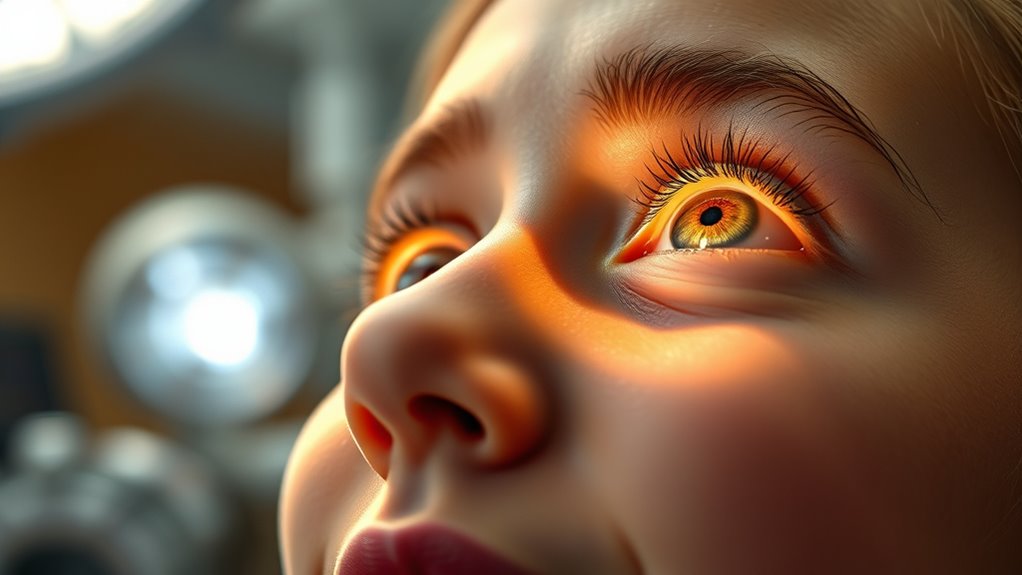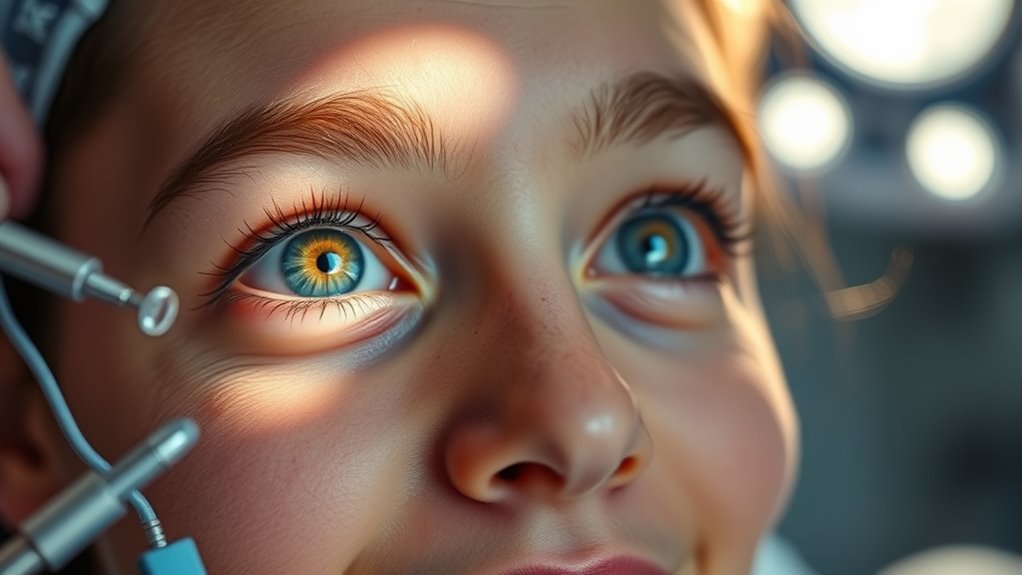Gene therapy can restore your sight by fixing the genetic defects causing hereditary blindness. It works by delivering healthy genes directly into your retinal cells using engineered viral vectors, encouraging repair and regeneration of damaged cells. This innovative approach aims for a long-lasting solution by addressing the root cause of vision loss. If you’re interested, you’ll discover how recent advancements are making this breakthrough therapy safer and more effective for patients like you.
Key Takeaways
- Gene therapy introduces healthy genes into retinal cells to repair or replace defective genes causing hereditary blindness.
- Viral vectors deliver functional genes that enable damaged photoreceptors to regenerate and restore vision.
- Clinical trials show improvements in light perception, contrast sensitivity, and visual acuity in treated patients.
- Advances in vector technology enhance safety, efficiency, and long-term effectiveness of gene-based eye treatments.
- Ongoing research aims to expand therapies to more hereditary eye conditions and improve treatment outcomes.

Researchers have achieved a breakthrough in treating certain types of blindness by using gene therapy to restore vision. This innovative approach harnesses genetic modification techniques to target the root causes of hereditary blindness, offering new hope to those affected. Instead of merely managing symptoms, gene therapy aims to repair or replace defective genes responsible for vision loss, paving the way for true retinal regeneration. As you learn about this development, you’ll see how this method could transform lives by restoring sight in ways previously thought impossible.
The core of this breakthrough lies in your ability to introduce healthy copies of specific genes directly into your retinal cells. By doing so, scientists can correct genetic mutations that cause degenerative eye conditions. This process involves delivering engineered viral vectors carrying functional genes into your retina, where they integrate and begin producing the necessary proteins. Over time, this genetic modification stimulates retinal regeneration—a process where damaged or dying cells are replaced or repaired, restoring the complex neural pathways that enable vision. This targeted intervention can halt or even reverse the progression of hereditary eye diseases, which traditionally led to irreversible blindness. Additionally, advances in vector design are crucial for improving the precision and safety of gene delivery, making treatments more effective.
Once inside your retina, these therapeutic genes activate pathways that promote cellular repair and renewal. For you, this means that the once-lost function of photoreceptor cells can be re-established. The result is a significant improvement in visual acuity and overall sight. What’s remarkable about this approach is its precision: it addresses the genetic root rather than just alleviating symptoms. As a patient, you benefit from a treatment that works at the molecular level, offering a more permanent solution compared to traditional therapies. Additionally, understanding the importance of cellular repair in creative practice can help researchers improve the focus and effectiveness of gene therapy techniques, ensuring better outcomes and patient experiences. The process of retinal regeneration through gene therapy is still evolving, but early clinical trials show promising results. You may experience improved light perception, better contrast sensitivity, and clearer vision as your retina begins to recover. Importantly, because this method targets the underlying genetic defect, the benefits could last for many years, reducing or even eliminating the need for ongoing treatment. Additionally, advances in delivery techniques and vector design continue to improve safety and efficiency, making this approach more accessible. Moreover, ongoing research aims to optimize viral vector technology to enhance gene delivery efficiency and minimize immune responses. Furthermore, ongoing innovations in genetic modification techniques hold promise for expanding the scope of treatable hereditary eye conditions.
Frequently Asked Questions
How Long Does the Gene Therapy Treatment Last?
You’re wondering about the duration effectiveness and treatment durability of gene therapy. Typically, the effects can last several years, but it varies based on individual factors and the specific condition treated. While some patients experience long-lasting benefits, others may find the effects diminish over time. Ongoing research aims to improve treatment durability, so you might need follow-up treatments or additional therapies to maintain vision improvements.
Are There Any Long-Term Side Effects?
You might wonder about long-term side effects, but current research shows that gene therapy generally has minimal risks. However, genetic risks like unintended mutations could occur, and immune responses might cause inflammation or reduce effectiveness over time. While most patients experience improvements, it’s crucial to stay monitored to catch any rare side effects early. Consulting with your doctor helps you understand potential risks tailored to your condition.
What Is the Success Rate Across Different Hereditary Blindness Types?
You’re curious about the success rate for hereditary blindness treatments. Overall, success rates vary, but many patients experience meaningful improvements, especially with certain types like Leber congenital amaurosis. While not every case responds equally, advancements continue to brighten the outlook. You can expect that gene therapy offers promising hope, with success rates steadily climbing across different hereditary blindness types, making the future look more hopeful for those seeking restored sight.
Can This Therapy Be Combined With Other Treatments?
You can combine gene therapy with other treatments through combination strategies and adjunct therapies. These approaches enhance overall effectiveness, addressing multiple aspects of hereditary blindness. By working together, treatments like pharmacological agents or vision aids complement gene therapy, potentially improving outcomes. Consulting your healthcare team helps determine the safest and most effective combination strategies tailored to your specific condition, maximizing your chances of restoring or preserving sight.
Is Gene Therapy Effective for All Age Groups?
You might wonder if gene therapy works across all age groups. Age considerations are important because older patients may have less neural plasticity, potentially reducing effectiveness. However, treatment accessibility has improved, making it available to many age ranges. While young patients often respond best, recent advances show promising results for adults too. Ultimately, your healthcare provider assesses individual factors to determine if gene therapy is suitable for your age.
Conclusion
This breakthrough isn’t just a medical milestone; it’s a renewal of hope shining through the darkness. As gene therapy rewrites the script of hereditary blindness, your world begins to bloom with vibrant hues and hidden details. Like dawn breaking after a long night, this innovation awakens new possibilities, reminding us that even in our most fragile moments, science can be the guiding light leading you back to sight’s embrace.









